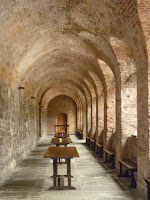Caring for heritage places can be a very exciting mission opportunity, but it can also cause financial concerns and heartache. No chapel steward wants to be the one to close the doors on a history of worship that may be well over 200 years.
As I travelled around at the beginning of August, it struck me that we measure our success as evangelists in very different ways. Church heritage can attract in people who might not go into a church for worship, but once there are often open to discussion with the stewards who welcome them, and that can become quite profound and be about their lives, spiritual condition and the relevance of faith. However, it's a moot point whether those people would ever come back to that church to join in with Sunday worship, even for one week. It's certainly unlikely if the visitors are passing through a place as tourists.
What we cannot know, however, is how the Holy Spirit has touched those people in that encounter - how we may have helped to change for the better their relationship with God and other people and their perceptions of the value of His Church.
That's why it's not enough to preserve our heritage. It's vital that we use our heritage to tell our story - why and how local people established their Methodist meetings and the impact that has had - and continues to have - on our society.
 The oldest Methodist church in use in East Anglia is in Walsingham - a market town well known for its shrines and pilgrimages relating to the Blessed Virgin Mary. A Wesleyan society was formed in 1779, and John Wesley visited Walsingham in 1781 and preached in Friday Market. He recorded in his journal visiting the Abbey and Friary, and lamented the damage caused during the Dissolution. The Methodist chapel was built in 1794. (Most of the downstairs interior is Victorian, but the Georgian box pews remain upstairs: just visible in this picture.) Today the chapel congregation regularly support the town's welcome to thousands of pilgrims, including many young people.
The oldest Methodist church in use in East Anglia is in Walsingham - a market town well known for its shrines and pilgrimages relating to the Blessed Virgin Mary. A Wesleyan society was formed in 1779, and John Wesley visited Walsingham in 1781 and preached in Friday Market. He recorded in his journal visiting the Abbey and Friary, and lamented the damage caused during the Dissolution. The Methodist chapel was built in 1794. (Most of the downstairs interior is Victorian, but the Georgian box pews remain upstairs: just visible in this picture.) Today the chapel congregation regularly support the town's welcome to thousands of pilgrims, including many young people.
Another oldest chapel on my trip was at Dunbar: the oldest Methodist chapel in Scotland. The picture shows sunset at the harbour.
But its a pretty close run thing - Arbroath's octagonal chapel is only a few years younger: here's the present interior. 

Arbroath is also a coastal town, made famous by its 'smokies' (smoked haddock). You can even get them in Arbroath in batter with chips!
And then there were the churches with grand schemes for further engaging with their local communities, which will include through their Methodist heritage: Broad Street in Spalding, the City of Edinburgh Methodist Church 'Nicolson Square' and Brunswick in Newcastle. If you live locally and are interested in history and heritage, each of these churches will have opportunities for enthusiasts to help them develop exhibits and tell their stories. They will need support searching regional archives, liaising with the museum services and - God willing - welcoming future visitors. If you are interested, you can always contact me and I'll put you in touch.
And then there were the churches with grand schemes for further engaging with their local communities, which will include through their Methodist heritage: Broad Street in Spalding, the City of Edinburgh Methodist Church 'Nicolson Square' and Brunswick in Newcastle. If you live locally and are interested in history and heritage, each of these churches will have opportunities for enthusiasts to help them develop exhibits and tell their stories. They will need support searching regional archives, liaising with the museum services and - God willing - welcoming future visitors. If you are interested, you can always contact me and I'll put you in touch.

















